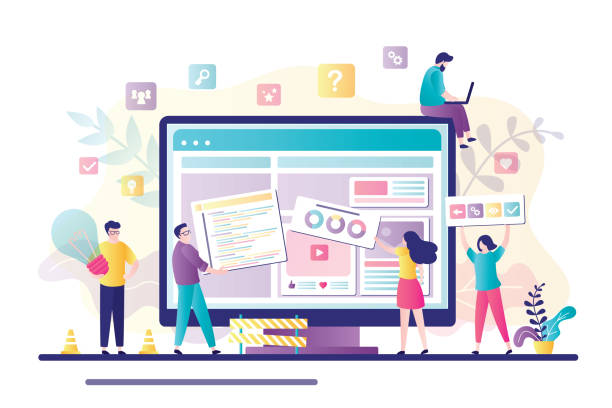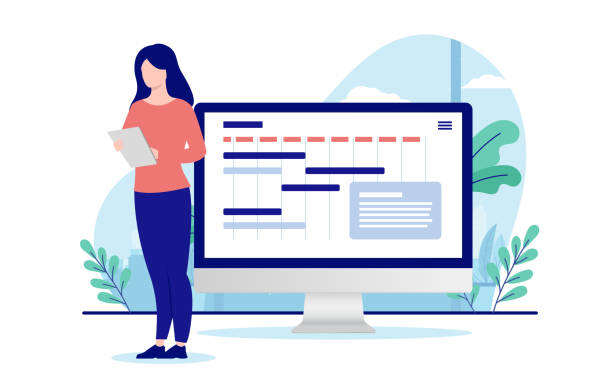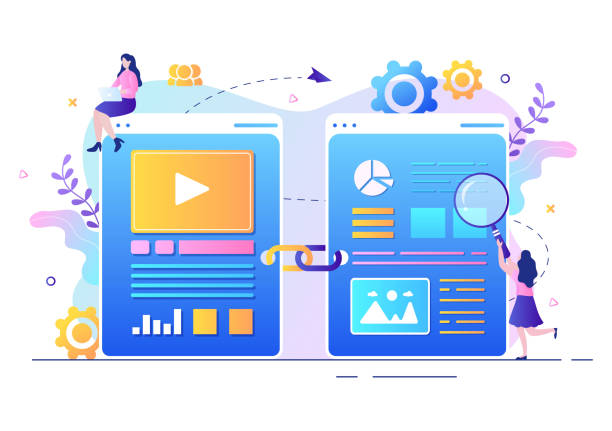Why is Multilingual Website Design Essential?

In the current era, the internet has crossed geographical boundaries and transformed into a global village.
However, many websites still offer content in only one specific language, usually English.
This approach overlooks the enormous potential of the #global_market and #international_users.
A single-language website undoubtedly misses countless opportunities for businesses, organizations, and even individuals.
The main question is: why should we limit ourselves to one language when billions of internet users worldwide speak and search in various languages?
The answer to this question lies in the importance of multilingual website design.
This is a strategic investment that allows you to connect with a wider audience, build their trust, and penetrate new markets.
Imagine a user from Germany looking for a product or service you offer, but your website is only in Persian; they would likely quickly leave your site and turn to your local competitors.
This is where the importance of multilingual website development becomes even more apparent.
This approach means transcending linguistic and cultural boundaries, opening a new door to attracting new customers and audiences.
Multilingual website design is not just a technical requirement, but a strategic necessity for any business with a global vision.
This action allows you to deliver your message in the native language of your global audience and create deeper engagement with them.
Is your current e-commerce website design not generating the sales you expect?
RasaWeb is an expert in professional e-commerce website design!
✅ An attractive and user-friendly site aimed at increasing sales
✅ High speed and security for an ideal shopping experience⚡ Get a free online store design consultation with RasaWeb!
Countless Benefits of a Multilingual Website

Multilingual website design brings numerous benefits to businesses and websites that go beyond mere linguistic communication.
Firstly, access to new markets and expanding the audience circle is the most important benefit.
By providing content in multiple languages, you can reach millions of new users worldwide who were previously unable to use your services due to language barriers.
This expansion means a potential increase in customers and business opportunities.
Secondly, there is a significant improvement in international SEO.
Search engines like Google specifically index multilingual websites and use hreflang tags to display the correct content to the correct user (based on language and geographical region).
This means an increase in rankings in search results for various keywords in different languages, which in turn leads to an increase in organic and targeted traffic.
Furthermore, building a global platform increases user credibility and trust.
When users can view your website’s content in their native language, they feel more comfortable and confident.
This not only increases conversion rates but also builds customer loyalty.
Multilingual websites introduce you as a global and trustworthy brand that cares about the needs of its customers worldwide.
Competition in global markets is fierce; therefore, having a multilingual website can give you a significant competitive advantage and differentiate you from competitors who have not yet paid attention to this vital aspect.
Technical Approaches in Implementing Multilingual Website Design

When proceeding with multilingual website design, there are several key technical approaches, each with its own advantages and disadvantages.
Choosing the right method depends on your resources, goals, and content structure.
The three main methods are: entirely separate domains, subdomains, and subdirectories.
The first method is to use entirely separate domains for each language.
For example, `example.com` for English and `example.de` for German.
This method is strong in terms of SEO because each domain is recognized as an independent entity and can achieve a high ranking in local search engines.
However, managing multiple domains can be complex and costly, requiring separate maintenance for each site.
The second method is to use subdomains.
In this case, each language has its own subdomain, such as `en.example.com` for English and `de.example.com` for German.
This method is slightly easier to manage than separate domains, but each subdomain is still evaluated independently by search engines.
This method is suitable for large organizations with independent language sections.
The third and most common method is to use subdirectories.
In this approach, each language is placed in a separate folder within the main domain, for example, `example.com/en/` and `example.com/de/`.
This method is very popular for SEO because it transfers the authority of the main domain to all language versions, and its management is simpler than the other two methods.
All content is under a single domain, which makes maintenance and updates easier.
It also has lower costs and is an excellent choice for most small and medium-sized websites.
The right choice at the beginning of the multilingual website development process is crucial because changing the method later can be costly and complex.
| Approach | Advantages | Disadvantages | Suitable for |
|---|---|---|---|
| Separate Domains (example.de) | Very strong local SEO, complete market separation | Complex and costly management, requires separate maintenance | Large companies with high budgets and focus on specific local markets |
| Subdomains (de.example.com) | Main domain authority, relatively easier management than separate domains | Less SEO authority compared to subdirectories, requires separate configurations | Businesses with independent language sections or a need for different brand identity in each region |
| Subdirectories (example.com/de/) | Strongest internal SEO, easy management, sharing of main domain authority | May not be as distinct for some users as subdomains | Most businesses, blogs, and corporate websites |
Beyond Mere Translation of Multilingual Content

One of the biggest mistakes in multilingual website design is the assumption that machine translation or even word-for-word translation is sufficient for website content.
In reality, to achieve true effectiveness, one must think of “localization” (Localization) beyond “translation”.
Localization means fully adapting the content and design to the culture, customs, preferences, and even local laws of the target audience.
For example, using the correct currency, date and time formats, local addresses, and phone numbers are all vital parts of localization.
Also, colors and images can have different meanings in various cultures; what is considered attractive and positive in one culture might be disrespectful or inappropriate in another.
The tone of writing is also very important; a formal and dry tone might be appropriate in one culture, while another culture might require a more friendly and informal tone.
Implementing a successful multilingual website requires a deep understanding of cultural differences.
For instance, keywords used for SEO in one language might have a different meaning in another language or might not be searched by users at all.
Even idiomatic expressions and proverbs must be carefully translated or replaced to avoid losing the original meaning or causing misunderstanding.
This is a specialized and very critical content and guidance.
Localization teams should consist of native speakers who are not only proficient in the language but also fully familiar with the culture, market, and expectations of the local audience.
This approach ensures that your content is not only understandable but also establishes a deep and meaningful connection with your target audience, turning them into loyal customers.
Ignoring this aspect can lead to a loss of investment in multilingual website design.
Do you dream of a thriving online store but don’t know where to start?
RasaWeb is your comprehensive e-commerce website design solution.
✅ Attractive and user-friendly design
✅ Increased sales and revenue⚡ Get a free consultation
User Experience (UX) in Multilingual Websites

One of the main pillars of success in multilingual website design is providing a flawless and intuitive user experience (UX).
Even if your content is correctly translated and localized, a poor user experience can quickly drive users away from your site.
The first and most important aspect is the easy placement and accessibility of the Language Switcher.
This option should be placed in a clear and visible location, such as the website header or footer.
Using the full language name (e.g., “Persian” instead of “FA”) or combining it with the respective country’s flag is usually better than just using flags, as flags do not always represent a specific language and can cause confusion.
In multilingual website implementation, attention must also be paid to writing differences.
Languages like Persian and Arabic are written from right-to-left (RTL), while most other languages are left-to-right (LTR).
This difference requires specific CSS settings and page layouts to ensure a smooth and natural reading experience for native users.
User interface elements, such as forms, buttons, and menus, must be correctly oriented and aligned.
Furthermore, ensuring design consistency across all language versions is very important.
Although it may be necessary to localize images or colors, the overall structure, navigation, and branding should remain consistent to maintain a sense of familiarity and trust for the user.
Page loading speed is also crucial in all language versions; international users also expect your site to load quickly.
These points demonstrate a comprehensive approach to multilingual website development that pays attention to all details of the user experience.
Finally, it should be noted that the language switching process should not cause a full page refresh or loss of user information (such as shopping cart contents).
A smooth and uninterrupted language change indicates professionalism and precision in design.
Search Engine Optimization (SEO) for Multilingual Websites

Success in multilingual website design will be incomplete without a strong SEO strategy.
International SEO requires specific approaches that are more complex than single-language SEO.
The most important tool in this regard is hreflang tags.
These tags help search engines display the correct version of a page based on the user’s language and geographical region.
Without hreflang, search engines might consider different language versions as duplicate content, which can harm your site’s SEO ranking.
Correct implementation of these tags requires great care and can be done in the HTML header, in the sitemap, or via HTTP Headers.
In addition to hreflang, conducting keyword research for each language separately is of high importance.
Keywords that are popular in one language might have a different meaning in another language or might not be searched by users at all.
Using local keyword research tools and consulting with expert native speakers can help you find suitable search terms.
Optimizing a multilingual website for SEO also includes creating separate sitemaps for each language.
This helps search engines correctly discover and index all your language pages.
Also, the link building strategy must be carried out carefully.
Acquiring backlinks from reputable websites relevant to each language and geographical region can increase your site’s authority and ranking in that specific market.
Finally, attention must also be paid to the URL Structure.
As mentioned in the technical section, using subdirectories (like example.com/fr/) is usually the best option for international SEO because it transfers the main domain’s authority to all language versions.
By observing these points, your multilingual website design can be well-visible in search engines and attract targeted traffic from around the world.
Tools and Platforms for Multilingual Website Design

To facilitate the process of multilingual website design and its content management, various tools and platforms are available, each with its own specific features and capabilities.
Choosing the right tool can significantly save time and cost and increase project efficiency.
One of the most popular options is using multilingual plugins in Content Management Systems (CMS) like WordPress.
Plugins like WPML (WordPress Multilingual Plugin) and Polylang provide translation management, language switching, and even multilingual SEO capabilities.
These plugins are very suitable for small to medium-sized websites and do not require deep technical knowledge.
For e-commerce platforms like Shopify and Magento, there are also built-in multilingual solutions or third-party plugins that allow for the translation of products, pages, and transactional emails.
These platforms usually focus on international user experience and local payment processes.
Beyond CMS plugins, there are Translation Management Systems (TMS) specifically designed for large-scale translation projects.
Tools like Smartling, Phrase, and MemoQ provide capabilities for managing glossaries, Translation Memory, and translation workflows.
These tools are ideal for large companies with a high volume of content and a need for continuous translation.
Some businesses might also turn to machine translation APIs (such as Google Cloud Translation API or DeepL API) to automate part of the translation process.
Although machine translation alone is not suitable for sensitive content, it can be used as a starting point for human translation or for translating a large volume of non-sensitive content.
The choice of the right tool depends on the project’s complexity, budget, and the level of control needed over the translation and localization process.
However, using specialized tools can turn the multilingual website design process into an efficient and successful experience.
| Category | Tool/Platform Name | Key Features | Suitable for |
|---|---|---|---|
| CMS Plugins | WPML (WordPress), Polylang (WordPress) | Management of post, page, category translations; multilingual SEO; language switcher | Small to medium WordPress sites, blogs, corporate sites |
| E-commerce Platforms | Shopify (with Apps), Magento (with Extensions) | Translation of products, descriptions, static pages; management of local payments | Online stores and e-commerce websites |
| Translation Management Systems (TMS) | Smartling, Phrase, MemoQ | Automation of translation workflow, translation memory, glossaries, translator team management | Large companies with a high volume of content, need for precise control over the translation process |
| Machine Translation APIs | Google Cloud Translation, DeepL API | Automatic translation of text and documents, integration capability with existing systems | Projects requiring fast translation of large volumes of non-sensitive content |
Common Mistakes in Multilingual Website Design and Solutions to Avoid Them

Despite the numerous benefits of multilingual website design, there are also common mistakes that can render your efforts fruitless.
Recognizing these mistakes and finding solutions to avoid them is the key to success in developing a globally-reaching website.
One of the biggest errors is sole reliance on machine translation without human review.
While machine translation tools have made significant progress, they are still unable to fully grasp cultural nuances, idioms, and appropriate tone.
This can lead to inaccurate, amusing, or even offensive translations that harm your brand’s credibility.
The solution is to always have translated content reviewed and edited by a professional native speaker.
Another mistake is ignoring international SEO.
Merely translating content and not paying attention to hreflang tags, local keyword research, and the correct URL structure will prevent search engines from correctly indexing your website and showing the right version to users.
This means losing valuable organic traffic.
Poor user experience (UX) design is also a common challenge.
Hiding the language switcher, failing to adapt to writing direction (RTL/LTR), or not supporting local currency can all confuse users and lead to their quick exit from the site.
The design must be intuitive, smooth, and localized.
Also, lack of continuous updating of translated content can be problematic.
If the main site content is updated but translated versions remain outdated, users will lose trust.
Content management processes should include simultaneous updates of all language versions.
Investing in multilingual website design requires ongoing commitment to maintaining quality and accuracy to achieve the best results.
Does your company’s website create a professional and lasting first impression in the minds of potential customers? RasaWeb, with its professional corporate website design, not only represents your brand’s credibility but also opens a path for your business growth.
✅ Create a powerful and reliable brand image
✅ Attract target customers and increase sales
⚡ Get a free consultation
Measuring Success and the Future of Multilingual Website Design

After investing in multilingual website design, it’s important to be able to measure its success and adjust future strategies based on data.
Analytical tools like Google Analytics can be very useful in this regard.
Using demographic and geographical reports, you can see which countries and regions your site traffic comes from and which languages attract the most visitors.
You can also monitor the conversion rate for each language version to understand which markets yield the highest returns.
Key Performance Indicators (KPIs) that should be considered include:
- Increased organic traffic from new regions
- Increased time spent on site (Dwell Time) for multilingual users
- Reduced bounce rate for international visitors
- Increased conversion rate in target markets
- Customer satisfaction in surveys related to local user experience
The future of multilingual website development is also evolving.
With advancements in artificial intelligence and machine learning, machine translation is continuously improving and will soon be able to provide higher quality translations that require less review.
Also, the emergence of voice search in various languages and the increasing importance of video content will create new challenges in localization.
Another trend is the concept of “Continuous Localization,” where the process of translating and updating content is done continuously and simultaneously with the development of the main content, rather than as a separate project.
This approach is particularly vital for companies with dynamic content and frequent updates.
These developments indicate that multilingual website design is a dynamic field that is constantly changing and evolving, requiring continuous attention.
Reaching the Global Market with Multilingual Website Design

In conclusion, it is clear that multilingual website design is no longer a luxury option, but a strategic necessity for any business and organization that intends to compete globally and achieve success.
The internet world is becoming more global every day, and ignoring a huge portion of users who speak languages other than your primary language means losing countless opportunities.
Investing in a multilingual website not only helps you penetrate new markets and expand your customer base but also enhances your brand’s credibility and earns the trust of international users.
This process involves technical, content, SEO, and user experience aspects, each requiring precision and expertise.
From choosing the appropriate URL structure and correctly implementing hreflang tags to precise content localization and providing a flawless user experience, every step plays a role in your ultimate success.
With a smart and planned approach to multilingual website design, you can benefit from its competitive advantages and solidify your position in international markets.
This allows you to deliver your message in the native language of your global audience and establish a deeper, more meaningful connection with them.
Remember that this is a long-term investment that not only helps you reach global users but also prepares your business for a global and successful future.
Ultimately, multilingual website development is a crucial step towards becoming a global player in the digital world.
Frequently Asked Questions
| No. | Question | Answer |
|---|---|---|
| 1 | What is multilingual website design? | Multilingual website design means creating a website whose content is available to users in several different languages. This is usually done through a simple user interface for language switching. |
| 2 | Why should we design a multilingual website? | Multilingual website design helps you reach a wider audience worldwide, provide a better user experience for international users, and improve your global SEO. |
| 3 | What are the main methods of implementing multilingualism on a website? | The main methods include using subdomains, subdirectories, or URL parameters for each language, as well as using entirely separate domains for each language. |
| 4 | For SEO, is it better to use a subdirectory or a subdomain? | From an SEO perspective, both subdirectories and subdomains can be effective. However, many SEO experts prefer subdirectories due to better transfer of the main domain’s authority. |
| 5 | What are the important tips for translating multilingual website content? | Translation should be done by native translators; content should be localized in addition to translation to match the target audience’s culture, and pure machine translation should be avoided. |
| 6 | What is the role of the hreflang tag in multilingual site SEO? | The hreflang tag helps search engines like Google display the correct language and regional version of a page to appropriate users, also preventing duplicate content issues. |
| 7 | Can a website be made multilingual without coding? | Yes, in Content Management Systems (CMS) like WordPress, powerful plugins such as WPML or Polylang exist that allow making a website multilingual without needing to code. |
| 8 | What are the challenges of multilingual website design? | Challenges include translation management, content localization, adherence to SEO principles for each language, technical support for different languages, and ensuring design consistency across different languages. |
| 9 | What is the difference between translation and localization? | Translation is merely rendering words from one language to another, while localization involves adapting content to the culture, customs, currency, date and time formats, and even appropriate colors for the target audience. |
| 10 | What is the best user experience (UX) for language switching? | A clear and accessible language switcher (usually in the header or footer), using the language name instead of a flag (due to regional diversity), and maintaining the user’s position after language change are important UX considerations. |
And other services of Rasa Web Advertising Agency in the field of advertising
Smart Digital Branding: A quick and efficient solution for increasing website traffic with a focus on intelligent data analysis.
Smart Custom Software: An exclusive service for growth in customer behavior analysis based on custom programming.
Smart Social Media: Transform campaign management with the help of key page optimization.
Smart Social Media: An effective tool for online growth with precise audience targeting.
Smart Marketplace: An effective tool for customer acquisition through marketing automation.
And hundreds of other services in the field of internet advertising, advertising consulting, and organizational solutions
Internet Advertising | Advertising Strategy | Advertorial
Resources
Benefits of Multilingual Website Design for Business Growth
Comprehensive Guide to Creating a Multilingual Website
Multilingual SEO: The Key to Success in Global Markets
Choosing the Best Platform for a Multilingual Website
? With RasaWeb Afarin Digital Marketing Agency, transform your business in the digital world. By providing comprehensive services including SEO, content marketing, and multilingual website design, we pave the way for your growth and success. For a free consultation and to learn more about our solutions, contact us today and shape the bright future of your business.
📍 Tehran, Mirdamad Street, next to Bank Markazi, Southern Kazeroon Alley, Ramin Alley, No. 6




